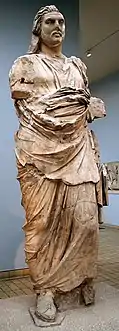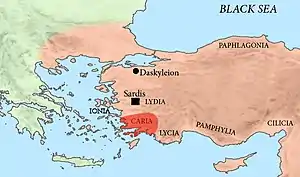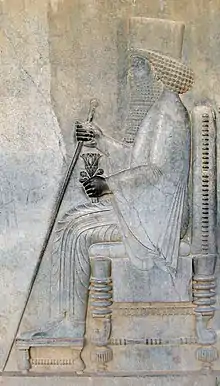Hecatomnids
The Hecatomnid dynasty or Hecatomnids were the rulers of Caria and surrounding areas from about 395–334 BCE, after Caria had left the Athenian alliance called the Delian League and returned under the control of the Achaemenid Empire. Before that, during the first period of Achaemenid rule, Caria was governed by the Lygdamid dynasty (520-450 BCE).
| Hecatomnid dynasty (Dynasts of Caria) | ||||||||||||||||
|---|---|---|---|---|---|---|---|---|---|---|---|---|---|---|---|---|
|
||||||||||||||||



The Hecatomnids were nominally satraps (governors) under the Achaemenid Empire, but ruled with considerable autonomy, and established a hereditary dynasty. The dynasty was founded by Hecatomnus and originally had its seat in Mylasa; Mausolus moved it to Halicarnassus.
Hecatomnus' five children succeeded him in succession. The dynasty engaged in sibling marriage, presumably to preserve royal power within the family.[1]
The dynasty ended with the conquests of Alexander the Great. Ada adopted him as her son, so that he would succeed to the rule of Caria.
The best-known monument of the dynasty is the Mausoleum that Artemisia II built in honor of her husband and brother Mausolus.
After the death of Pixodarus, the last member of the Hecatomnids, Orontobates was sent by the king of Persia to succeed him. Orontobates, a Persian, married the daughter of Pixodarus, and ruled from 335 to 334.
After the conquest of Alexander the Great, Ada again ruled from 334 to 326 under the Macedonian Empire.
Members
- Hecatomnus, ruled 395–377
- Mausolus, son of Hecatomnus, ruled 377–353
- Artemisia II, daughter of Hecatomnus, wife of Mausolus, ruled 353–351
- Idrieus, son of Hecatomnus, ruled 351–344
- Ada, daughter of Hecatomnus, wife of Idrieus, ruled 344–340 and 334–326 (under Alexander the Great)
- Pixodarus, son of Hecatomnus, ruled 340–335
- (Orontobates, Achaemenid Satrap), ruled 335-334
- Ada (second reign), ruled 334-326 under the Macedonian Empire
Bibliography
- Stephen Ruzicka, Politics of a Persian Dynasty: The Hecatomnids in the Fourth Century B.C. , University of Oklahoma Press, 1992, ISBN 0806124601 (not seen).
- Stephen Ruzicka, "The Hecatomnid Dynasty of Caria" (not seen) abstract
- "Hecatomnid dynasty" at livius.org
References
- "Women in Dunasteia in Caria". The American Journal of Philology. 126. Spring 2005.
